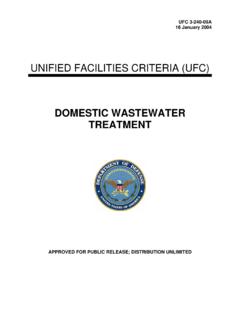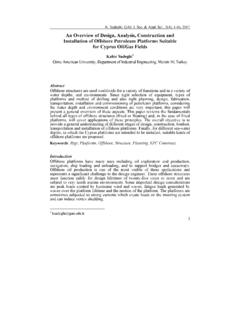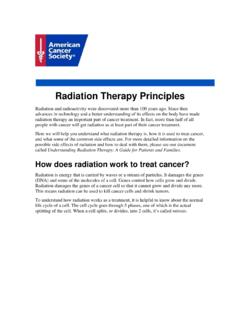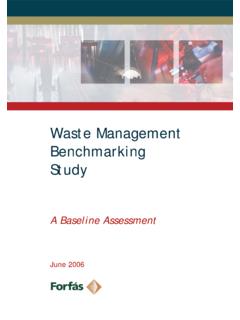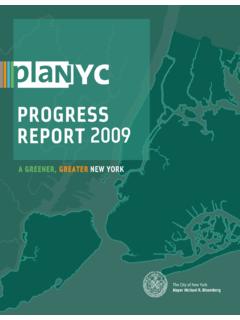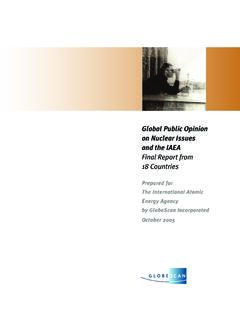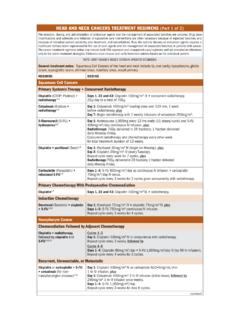Transcription of Second Cancers Caused by Cancer Treatment
1 Second Cancers Caused by Cancer Treatment Advances in radiation therapy and chemotherapy have increased the chances of survival for many people with Cancer today. People with Cancer are often living longer, so it's becoming more important to study the long-term effects of Cancer Treatment . Of all the possible late complications of Cancer Treatment , developing a Second Cancer is one of the most serious. People can have more than one Cancer in their lifetime. Cancer is a very common disease, and not all Second Cancers are due to Cancer Treatment . For example, certain inherited gene changes can increase a woman's risk for both breast and ovarian Cancer . Also, being exposed to certain Cancer - causing substances, like tobacco smoke, can put a person at higher risk for several different Cancers , such as Cancers of the lung, larynx (voice box), throat, and mouth. Even though it is hard to separate out the exact cause of any one person's Cancer , here we will try to focus on the risk of Second Cancers that may be linked to past Cancer Treatment .
2 Treatments linked to the development of Second Cancers Radiation therapy Radiation therapy was recognized as a potential cause of Cancer many years ago. In fact, much of what we know about the possible health effects of radiation therapy has come from studying survivors of atomic bomb blasts in Japan. We also have learned from workers in certain jobs that included radiation exposure, and patients treated with radiation therapy for Cancer and other diseases. Leukemia Acute myelogenous leukemia (AML), chronic myelogenous leukemia (CML), and acute lymphoblastic leukemia (ALL) have been linked to past radiation exposure. Myelodysplastic syndrome (MDS), a bone marrow disorder that can turn into acute leukemia, has also been linked to past radiation exposure. The risk of these diseases after radiation Treatment depends on a number of factors such as: How much of the bone marrow was exposed to radiation The amount of radiation that reached active bone marrow The radiation dose rate (how much was given in each dose, how long it took to give the dose, and how often it was given).
3 The person's age when they were treated with radiation does not seem to be a risk factor. Most cases usually develop within several years of radiation Treatment , peaking at 5 to 9. years after exposure. Then the number of cases developing slowly declines over the following years. Solid tumors In contrast, other Cancers , which are mostly solid tumors, have been shown to take much longer to develop. Most of these Cancers are not seen for at least 10 years after radiation therapy, and some are diagnosed even more than 15 years later. The effect of radiation on the risk of developing a solid tumor Cancer depends on such factors as: The dose of radiation The area treated The age of the patient when they were treated with radiation In general, the risk of developing a solid tumor after radiation Treatment goes up as the dose of radiation increases. Some Cancers require larger doses of radiation than others, and certain techniques require more radiation. For example, intensity modulated radiation therapy (IMRT) helps to protect tissues that are more easily injured by radiation, but a larger dose of radiation overall must be used.
4 The area treated is also important, since these Cancers tend to develop in or near the area that was treated with radiation. Certain organs, such as the breast and thyroid, seem to be more likely to develop Cancers after radiation than others. Age at the time of Treatment also affects the risk of solid tumors. For example, the risk of developing breast Cancer after radiation is higher in those who were treated when they were young compared with those given radiation as adults. The chance of developing breast Cancer after radiation seems to be highest in those exposed as children. Risk decreases as the age at the time of radiation increases, with little or no increase in breast Cancer risk among women who had radiation after the age of 40. Age at the time of radiation Treatment has a similar effect on the development of other solid tumors, including lung Cancer , thyroid Cancer , bone sarcoma, and gastrointestinal or stomach Cancers . Other factors can also affect the risk of radiation-related Cancers .
5 Smoking, for example, increases the risk of lung Cancer after radiation even more. Early menopause can lower the risk of radiation-related breast Cancer . For some Cancers , the risk is higher if chemotherapy was given along with radiation. More research will probably be done in the future to look at how genetics and radiation therapy interact, as well as the link between radiation therapy and other Cancer -causing agents. Chemotherapy The Cancer most often linked to chemotherapy (chemo) as the cause is acute myelogenous leukemia (AML). In many cases, myelodysplastic syndrome (MDS), a bone marrow problem that is sometimes called a type of Cancer , occurs first, then turns into AML. Acute lymphocytic leukemia (ALL) has also been linked to chemo. Chemo is known to be a higher risk factor than radiation therapy in causing leukemia. Some solid tumor Cancers have also been linked to chemo Treatment for certain Cancers , such as testicular Cancer . Alkylating agents Certain types of chemo drugs called alkylating agents have been shown to increase the risk of AML when used to treat certain Cancers like Hodgkin disease, non-Hodgkin lymphoma (NHL), ovarian, lung, and breast Cancer .
6 Alkylating agents known to cause leukemia include: Mechlorethamine Chlorambucil Cyclophosphamide (Cytoxan ). Melphalan Semustine Lomustine (CCNU). Carmustine (BCNU). Prednimustine Busulfan Dihydroxybusulfan The risk gets higher with higher drug doses, longer Treatment time, and higher dose- intensity (meaning that more drug is given over a short period of time). Studies have shown that leukemia risk begins to rise about 2 years after Treatment with alkylating agents, becomes highest after 5 to 10 years, and then declines. Alkylating agents often cause MDS first, which then progresses into an acute leukemia. MDS and leukemia that develop after Treatment with alkylating agents can be hard to treat and tends to have a poor outcome. Often, Cisplatin The chemo drug cisplatin is not an alkylating agent, but it attacks Cancer cells in much the same way. Cisplatin seems to increase the risk of leukemia, too. This leukemia is hard to treat and tends to have a poor outcome, much like the leukemia linked to the alkylating agents.
7 But the risk of developing leukemia after Treatment with cisplatin is not as great as with the alkylating agents. Cisplatin is used to treat a lot of different Cancers , including lung, testicular, and ovarian Cancer . The risk of leukemia rises as the amount of drug used gets higher. The risk of developing leukemia increases even more if radiation is given along with the cisplatin. Topoisomerase II inhibitors In more recent years, a class of chemo drugs called topoisomerase II inhibitors have also been found to cause leukemia, mainly AML. Drugs in this class include etoposide, teniposide, and mitoxantrone. Leukemia develops sooner after Treatment with these drugs than the leukemia from alkylating agents. Most cases are found within 2 or 3 years of Treatment . Etoposide (VP-16, Etopophos , or Vepesid ) is used to treat patients with lung Cancer , testicular Cancer , ALL, and other Cancers , and is linked with an increased risk of developing AML. Treatment of childhood ALL with teniposide is also thought to increase the risk of AML.
8 Mitoxantrone (Novantrone ), used to treat breast Cancer , lymphoma, and other Cancers , can also cause acute leukemia. Leukemia from these drugs acts differently from the leukemia from alkylating agents it tends to respond to Treatment better and has a better outlook. Also, these drugs don't often cause MDS first. Anthracyclines More recently, evidence has suggested that the class of chemotherapy drugs called anthracyclines may also cause AML. Examples of anthracyclines include the drugs doxorubicin (Adriamycin ), daunorubicin, and epirubicin (Ellence ). These drugs are also topoisomerase II inhibitors, but are less likely to cause leukemia than etoposide, teniposide, and mitoxantrone. Cancers linked to the development of Second Cancers No matter what type of Cancer is treated, treatments such as radiation and chemotherapy can lead to a Second Cancer in the long run. Because it can take many years for Treatment - related Cancers to develop, they have been studied best in those who have lived a long time after being treated.
9 Successfully treating a first Cancer gives a Second Cancer the time (and the chance) to develop. The Cancers discussed in this section were some of the first Cancers in which Treatment led to long-term survival. It is likely that we will see Second Cancers developing after some other Cancers as Treatment and survival improves. Hodgkin disease Survivors of Hodgkin disease (HD) have a risk of developing another Cancer that is 2 to 3. times that of people who didn't have HD (the general population). Overall, the risk of a Second Cancer is more than 20% (1 in 5) in the first 20 years after Treatment . Risk of leukemia Survivors of HD have an increased risk of acute leukemia and myelodysplastic syndrome (MDS) that is mainly linked to Treatment with chemotherapy (chemo). The risk with chemo is highest if an alkylating agent was used, particularly when the combination of drugs known as MOPP (mechlorethamine, vincristine/Oncovin, prednisone, and procarbazine) was used as the main chemo regimen.
10 Leukemia and MDS are much less common in people treated with regimens that include the combination known as ABVD. (doxorubicin/Adriamycin, bleomycin, vinblastine, and dacarbazine). Some patients with HD are treated with stem cell transplant. Most often, this is used for HD that has come back after Treatment (or never went away in the first place). Patients with HD treated with stem cell transplant have a higher risk of leukemia and MDS that seems to be related to the additional chemo that is given prior to transplant. Treating HD with radiation alone has little effect on leukemia risk, but adding radiation to chemo may increase the risk from the chemo even further. The chance of getting leukemia after HD is related to the patient's age when they were treated, with the highest risk seen in those who were 35 or older during Treatment . The risk also seems to go up as the amount of chemo used increases. Risk of non-Hodgkin lymphoma The risk of non-Hodgkin lymphoma (NHL) is also higher in those who survive HD.
